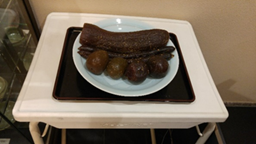Gravity(Attraction) of Kyoto 16 Pottery and Pickles Ⅲ Narazuke
Yoshie Doi

Narazuke is a type of pickle made by salting vegetables such as cucumber, watermelon, and ginger and then repeatedly soaking them in fresh sake lees. The name originally came from melons pickled in sake lees, and it has been eaten since ancient times.
The question of why Kasu-zuke, which is made by preserving vegetables in hishio (seaweed) and lees, is called Nara pickles comes from the fact that wooden tablets (present-day courier delivery slips) excavated from the residence of Nagaya king residence in Heijokyo contain references to Kasu-tsukeuri, Kasu-zuke-kan-nasubi, and Hishio-tsukeuri, suggesting that this pickle originated in Nara. The Engishiki (Ceremony of the Heian Period) also mentions “Kasu-zuke-uri” (liquor lees-pickled melon), which is thought to be the prototype of Nara pickles.
The oldest document that mentions Narazuke is the Yamashina Kareiki, which mentions it as a souvenir from Uji in 1492. From this period onwards, Narazuke became commercialized and popular. In particular, Itoya Sosen, a Nara herbal medicine doctor, pickled white melon in sake lees and sold it as Narazuke.
According to the book “Naniwa Zue,” Tokugawa Ieyasu (1542-1616) is said to have loved the taste of Narazuke, which was presented to him as a Nara specialty when he set up camp at Ashihi no Mori during the Summer Siege of Osaka. Afterwards, even after he took control of the country and returned to Edo, he could not forget the taste, and he was such a fan of Narazuke that he summoned Itoya Sosen, a doctor who was skilled at making Narazuke, from Nara and had him become a merchant for making Narazuke for the shogunate.
Ieyasu was such a health freak that even doctors were amazed, and he mixed his own herbs and Chinese medicines, which allowed him to live to the age of 75. This was at a time when the average life expectancy was 30 to 40 years old, so this shows just how long he lived.
As sake technology developed, Narazuke began to be made in Kyoto as well. It is said that there was delicious Narazake in Nara, and Kyoto also produced a lot of delicious sake. Mirin is made by slowly aging glutinous rice, rice koji, shochu, and other ingredients, and Tanakacho’s Narazuke is pickled in this mirin. Since the company was founded in 1789 (the first year of the Kansei era), they have been pickling their homemade Narazuke in mirin, aging them for two years and re-pickling them multiple times to achieve a mellow flavor. This pickling method has remained unchanged for 200 years since the company was founded. It is a familiar taste that I have been enjoying since I was a child.
During the Nara period, the clear liquid from Doburoku was drunk as sake, and salted vegetables were pickled in the sediment at the bottom, which was a valuable preserved food. The sake of that time was different from today’s Doburoku, which was a cloudy white. The lees were not the lees from the sake being pressed, but rather vegetables pickled in the thick sediment that accumulated at the bottom of Doburoku, which was used as a preserved food. It seems that this was highly valued by the upper class at the time.
Nara pickles and grilled eel are the perfect side dishes. They are also said to stimulate the stomach, relieve heartburn, break down fat, and aid in the absorption of vitamins and minerals.
Eating eel fat with Nara pickles, which have a high alcohol content, leaves your mouth feeling refreshed. Furthermore, Nara pickles contain melanoidin, which is expected to help with the absorption of vitamins and minerals contained in eel. This combination has been a staple since the Meiji period.
The end of document
Translated by Masami Otani
